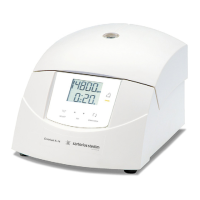
Do you have a question about the Sartorius Stedim Biotech CENTRISART A-14 and is the answer not in the manual?
| Brand | Sartorius Stedim Biotech |
|---|---|
| Model | CENTRISART A-14 |
| Category | Laboratory Equipment |
| Language | English |
Explains the significance of the operating manual for safe centrifuge use and compliance with regulations.
Defines the proper application of centrifuges and clarifies improper use, stating manufacturer liability.
Outlines warranty terms and conditions, excluding claims due to improper use or non-compliance.
Lists the standard components included with the centrifuge package.
Details the physical layout, functional elements, and name plate of the centrifuge.
Explains centrifugation principles, areas of application, and the relationship between speed, radius, and force.
Illustrates and explains the various safety symbols and markings used on the centrifuge.
Defines the responsibilities of the operator and qualified personnel for safe operation.
Covers electrical and mechanical safety, including precautions during operation and setup.
Details safety measures for fire prevention, chemical/biological hazards, and centrifugation setup.
Addresses plastic resistance, rotor service life, and safety devices like the lid lock.
Covers internal system checks, accident procedures, and remaining operational hazards.
Provides the physical dimensions and weight of the centrifuge unit.
Specifies the required environmental conditions for safe storage of the centrifuge.
Offers guidance on safely transporting the centrifuge, noting its weight.
Details the packaging procedure for transport, emphasizing the use of original packaging.
Defines the necessary conditions for the installation site, including ventilation and stability.
Covers connection requirements, operating voltage matching, and fuse specifications.
Guidance for the initial start-up of the centrifuge after installation.
Instructions for switching the centrifuge on and operating the lid.
Detailed steps for installing various rotors and accessories.
Overview of the centrifuge's construction, drive, and display system.
Details the microprocessor-controlled electronics and customizable parameters.
Describes active safety features like lid lock, lid clamp, and system checks.
Identifies and explains the function of the centrifuge's operating elements.
Covers starting, interrupting, and managing centrifugation runs.
Explains how to set and change speed and relative centrifugal force (RCF).
Details how to set and modify the centrifugation runtime.
Describes the softstart and softstop features for acceleration and deceleration control.
Provides instructions on how to select the installed rotor for correct operation.
Instructions for properly switching off the centrifuge.
Describes how malfunctions are indicated and general troubleshooting steps.
Step-by-step guide for manually opening the lid during a power failure.
A comprehensive table listing error codes, their causes, and recommended measures.
Covers routine maintenance for the centrifuge and accessories, including cleaning agents.
Details maintenance for plastic accessories, rotors, and microhaematocrit rotors.
Procedures for handling glass breakage and removing particles from the rotor chamber.
Guidelines for sterilizing and disinfecting the centrifuge and its accessories.
Recommends professional service checks and details service work requirements.
Procedures for returning defective parts, including decontamination declarations.
Troubleshooting steps for when the unit does not start or malfunctions.
Provides detailed technical specifications and environmental operating conditions.
Explains formulas for RCF, density, and their interdependencies.
Graphical representation of speed, radius, and RCF relationships.
Guides users through common problems and resolution steps.
Explains how error modes are indicated and provides a table of error codes.
Lists compatible accessories, including rotors and adapters, with specifications.
Information regarding the declaration of decontamination and return forms.
Graphical representation of speed, radius, and RCF relationships.
Details the service life and autoclaving limits for various rotors and accessories.
Provides data on the resistance of various materials to different chemicals.